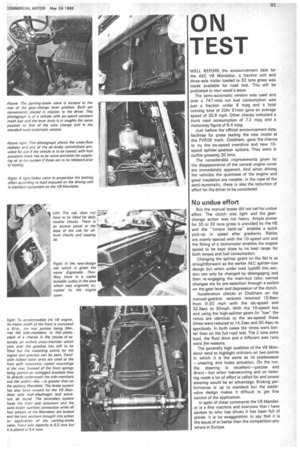ON TEST
Page 85

If you've noticed an error in this article please click here to report it so we can fix it.
WELL BEFORE the announcement date for the AEC V8 Mandator, a tractive unit and three-axle trailer loaded to 32 tons gross was made available for road test. This will be published in next week's issue. The semi-automatic version was used and over a 747-mile run fuel consumption was just a fraction under 6 mpg and a total running time of 20hr 51min gave an average speed of 35.8 mph. Other checks indicated a trunk road consumption of 7.2 mpg and a motorway figure of 6.4 mpg.
Just before the official announcement date, facilities for press testing the new model at the FVRDE track, Chobharn, gave the chance to try the six-speed overdrive and new 10speed splitter-gearbox options. They were in outfits grossing 30 tons.
The considerable improvements given by the disappearance of the central engine cover are immediately apparent. And when driving the vehicles the quietness of the engine and good insulation are notable; in the case of the semi-automatic, there is also the reduction of effort for the driver to be considered.
No undue effort
But the manual boxes did not call for undue effort. The clutch was light and the gearchange action was not heavy. Ample power for 30 or 32 tons gross is provided by the V8 and the "torque back-up" enables a quick pick-up in speed after gradients. Ratios are evenly spaced with the 10-speed unit and the fitting of a tachometer enables the engine speed to be kept close to its best range for both torque and fuel consumption.
Changing the splitter gears on the flat is as straightforward as the earlier AEC splitter-box design but when under load (uphill) this section can only be changed by disengaging and then re-engaging the main-box ratio; normal changes are by pre-selection through a switch on the gear lever and depression of the clutch.
Acceleration checks at Chobham on the manual-gearbox versions returned 15.6sec from 0-20 mph with the six-speed and 32.6sec to 30mph. With the 10-speed box and using the high-splitter gears (in "low" the ratios are identical to the six-speed) these times were reduced to 14.2sec and 30.4sec respectively. In both cases the times were better than on the full road test. The 2 tons extra load, the fluid drive and a different axle ratio were the reasons.
The generally high qualities of the V8 Mandator tend to highlight criticism on two points in which it is the same as its predecessor —steering and brake actuation. On the run, the steering is excellent—precise and direct—but when manoeuvring and on twisting roads a lot of effort is called for and power steering would be an advantage. Braking performance is up to standard but the pedalvalve design makes it difficult to get fine control of the application.
In spite of these comments the VS Mandator is a fine machine and everyone that I have spoken to who has driven it has been full of praise. It is no exaggeration to say that it is the equal of or better than the competition anywhere in Europe.








































































































































